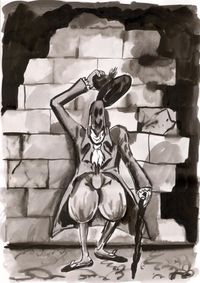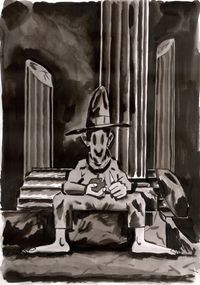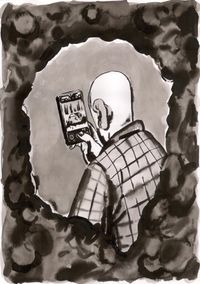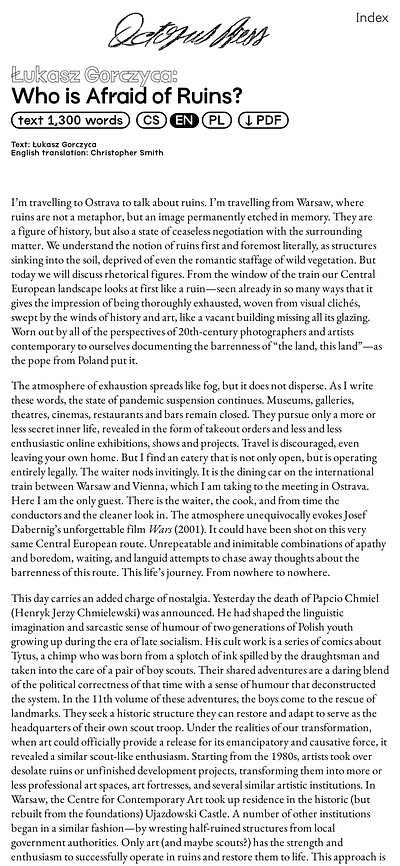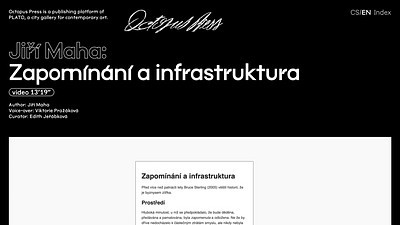The Ruin
Text: Georg Simmel
Illustration: Ivo Škuta
English translation: David Kettler
Architecture is the only art in which the great struggle between the will of the spirit and the necessity of nature issues into real peace: that in which the soul in its upward striving and nature in its gravity are held in balance. In poetry, painting, music, the laws governing the materials must be made dumbly submissive to the artistic conception which, in the perfect work, wholly and invisibly absorbs them. Even in sculpture the tangible piece of marble is not the work of art; what stone or bronze of themselves contribute to the work has its effect only as a means of expressing spirit. Although architecture, too, uses and distributes the weight and carrying power of matter according to a plan conceivable only in the human soul, within this plan the matter works by means of its own nature-carrying the plan out, as it were, with its own forces. This is the most sublime victory of the spirit over nature-a situation like that which obtains when we know how to guide a person so that he realizes our will through his own. His will has not been overpowered; rather, the very tendency of his own nature is made to execute our plan.
This unique balance-between mechanical, inert matter which passively resists pressure, and informing spirituality which pushes upward-breaks, however, the instant a building crumbles. For this means nothing else than that merely natural forces begin to become master over the work of man: the balance between nature and spirit, which the building manifested, shifts in favor of nature. This shift becomes a cosmic tragedy which, so we feel, makes every ruin an object infused with our nostalgia; for now the decay appears as nature's revenge for the spirit's having violated it by making a form in its own image. The whole history of mankind is a gradual rise of the spirit to mastery over the nature which it finds outside, but in a certain sense also within, itself. If in the other arts the spirit bends the forms and events of this nature to its command, in architecture it shapes nature's masses and inherent forces until, as if of their own accord, they yield and the artistic conception is made visible. But the necessities of matter submit to the freedom of the spirit, and its vitality is expressed without residue in nature's merely weighing and carrying forces, only so long as the building remains perfect. The moment its decay destroys the unity of the form, nature and spirit separate agam and reveal their world-pervading original enmity-as if the artistic formation had only been an act of violence committed by the spirit to which the stone unwillingly submitted; as if it now gradually shook off this yoke and returned once more into the independent lawfulness of its own forces.
But this makes the ruin a more meaningful, more significant phenomenon than are the fragments of other destroyed works of art. A painting from which particles of paint have fallen off, a statue with mutilated limbs, an ancient text of poetry from which words or lines are lost-all of these have effect only according to what is still left in them of artistic formation or what the imagination can construe of it from these remnants. Their immediate appearance is no artistic unity; it offers us nothing but a work of art imperfect through the reductions it has undergone. The ruin of a building, however, means that where the work of art is dying, other forces and forms, those of nature, have grown; and that out of what of art still lives in the ruin and what of nature already lives in it, there has emerged a new whole, a characteristic unity. To be sure, from the standpoint of that purpose which the spirit has embodied in palace and church, castle and hall, aqueduct and memorial column, the form in which they appear when decayed is a meaningless incident. Yet a new meaning seizes on this incident, comprehending it and its spiritual form in a unity which is no longer grounded in human purposiveness but in that depth where human purposiveness and the working of non-conscious natural forces grow from their common root. For this reason a good many Roman ruins, however interesting they may be otherwise, lack the specific fascination of the ruin-to the extent, that is, to which one notices in them the destruction by man; for this contradicts the contrast between human work and the effect of nature on which rests the significance of the ruin as such.
Such a contradiction is engendered not only by man's positive action but also by his passivity when (and because) he strikes us as an element of mere nature. This characterizes a good many urban ruins, like those, still inhabited, often found in Italy off the main road. In these cases, what strikes us is not, to be sure, that human beings destroy the work ofman-this indeed is achieved by nature-but that men let it decay. From the standpoint of the idea of man, such indifference is, so to speak, a positive passivity, whereby man makes himself the accomplice of nature and of that one of its inherent tendencies which is dramatically opposed to his own essential interests. Here the inhabited ruin loses for us that sensuous-suprasensuous balance of the conflicting tendencies of existence which we see in the abandoned one. This balance, indeed, gives it its problematical, unsettling, often unbearable character. Such places, sinking from life, still strike us as settings of a life.
In other words, it is the fascination of the ruin that here the work of man appears to us entirely as a product of nature. The same forces which give a mountain its shape through weathering, erosion, faulting, growth of vegetation, here do their work on old walls. Even the charm of alpine forms-which for the most part, after all, are clumsy, accidental, artistically insipid-rests on the felt counterplay of two cosmic tendencies: volcanic eruptions or gradual stratification have built the mountain upward; rain and snow, weathering and landslides, chemical dissolution and the effect of gradually intruding vegetation have sawed apart and hollowed out the upper ledge, have cast downward parts of what had been raised up, thus giving the contour its form. In this form, we thus feel the vitality of those opposing tendencies-and, instinctively sensing these antitheses in ourselves, we notice, beyond everything merely formal and aesthetic, the significance of the configuration in whose serene unity they have their synthesis.
In the ruin, these antitheses are distributed over even more widely segmented parts of existence. What has led the building upward is human will; what gives it its present appearance is the brute, downward-dragging, corroding, crumbling power of nature. Still, so long as we can speak of a ruin at all and not of a mere heap of stones, this power does not sink the work of man into the formlessness of mere matter. There rises a new form which, from the standpoint of nature, is entirely meaningful, comprehensible, differentiated. Nature has transformed the work of art into material for her own expression, as she had previously served as material for art.
According to its cosmic order, the hierarchy of nature and spirit usually shows nature as the substructure, so to speak, the raw material, or semi-finished product; the spirit, as the definitely formative and crowning element. The ruin reverses this order: what was raised by the spirit becomes the object of the same forces which form the contour of the mountain and the bank of the river. If in this way there emerges an aesthetic significance, it also ramifies into a metaphysical one, in the manner revealed by patina on metal and wood, ivory and marble. In patina, too, a merely natural process is set off on the surface of a human product and makes for the outgrowth of a skin which completely covers up the original one. That the product becomes more beautiful by chemical and physical means; that what is willed becomes, unintentionally and unenforceably, something obviously new, often more beautiful, and once more self-consistent: this mysterious harmony is the fantastic fascination of patina which cannot be wholly accounted for by analyzing our perception of it.
This is the fascination of the ruin, too; but in addition, the ruin has another one of the same order: the destruction of the spiritual form by the effect of natural forces, that reversal of the typical order, is felt as a return to the “good mother,” as Goethe calls nature. Here the saying that all that is human “is taken from earth and to earth shall return” rises above its sad nihilism. Between the not-yet and the no-longer lies an affirmation of the spirit whose path, it is true, now no longer ascends to its peak but, satiated by the peak's riches, descends to its home. This is, as it were, the counterpart of that “fruitful moment” for which those riches which the ruin has in retrospect are still in prospect. That the overwhelming of a work of the human will by the power of nature can have an aesthetic effect at all suggests that nature has a never completely extinguished rightful claim to this work, however much it may be formed by the spirit. In its material, its given state, it has always remained nature, and if now nature becomes once more completely mistress over it, she is merely exercising a right which until now has remained latent but which she never, so to speak, has renounced.
For this reason, the ruin strikes us so often as tragic-but not as sad-because destruction here is not something senselessly coming from the outside but rather the realization of a tendency inherent in the deepest layer of existence of the destroyed. For this reason, too, the aesthetically satisfying impression, which is associated with the tragedy or secret justice of destruction, is so often lacking when we describe a person as a “ruin.” For even when we mean by this that the psychic layers we designate as natural in the narrower sense-the drives or inhibitions connected with the body, the inert, the accidental, that which points toward death have become master over the specifically human, rationally valuable ones, we still do not feel that a latent right is being realized through these tendencies. Rather, such a right does not exist at all. We believe-rightly or wrongly-that such derogations, inimical to the spirit, do not inhere in the nature of man in its deepest sense: they have a right to everything external that is born with him, but not to man himself. Reflections and complexities in other contexts aside, man as a ruin, therefore, is so often more sad than tragic, lacking that metaphysical calm which attaches to the decay of a material work as by virtue of a profound a priori.
When we speak of “returning home,” we mean to characterize the peace whose mood surrounds the ruin. And we must characterize something else: our sense that these two world potencies the striving upward and the sinking downward-are working serenely together, as we envisage in their working a picture of purely natural existence. Expressing this peace for us, the ruin orders itself into the surrounding landscape without a break, growing together with it like tree and stone-whereas a palace, a villa, even a peasant house, even where they fit perfectly into the mood of their landscape, always stem from another order of things and blend with that of nature only as if in afterthought. Very old buildings in open country, and particularly ruins, often show a peculiar similarity of color to the tones of the soil around them. The cause of this must be somehow analogous to that which constitutes the charm of old fabrics, too: however heterogeneous their colors may have been when new, the long common destinies, dryness and moisture, heat and cold, outer wear and inner disintegration, which they have encountered through the centuries produce a unity of tint, a reduction to the same common denominator of color which no new fabric can imitate. In a similar way, the influences of rain and sunshine, the incursion of vegetation, heat, and cold must have assimilated the building abandoned to them to the color tone of the ground which has been abandoned to the same destinies. They have sunk its once conspicuous contrast into the peaceful unity of belonging.
The ruin conveys the impression of peace from yet another perspective. On the one side of that typical conflict stood the purely external form or symbolism of peace: the contour of the mountain as defined by the building up and the breaking down. But in respect to the other pole of existence, peace lives entirely within the human soul-that battlefield between nature, which the soul is itself, and spirit, which the soul is itself. The forces which one can designate only by the spatial simile of upwardstriving are at work continuously in our soul, continuously interrupted, deflected, overcome by other forces which work in us as what is dull, mean, “merely-natural.” The way in which these two variously mingle in extent and manner yields, at every mment, the form of our soul. But neither by the most decisive victory of one of these two parties nor by their compromise does it ever arrive at a definitive state. For not only does the restless rhythm of the soul not tolerate it; but, more important, behind every single event, every single impulse that comes from one or the other of these two directions, there is something which lives on, and there are claims which the decision just made does not put to rest. This gives the antagonism between the two principles something unfinishable, formless, breaking every frame.
The unending demands of both principles impose on the soul an interminability of the moral process, a profound absence of a well-rounded organization palpably at rest. In this lies perhaps the ultimate formal ground of the animosity of aesthetic against ethical natures. Wherever we perceive aesthetically, we demand that the contradictory forces of existence be somehow in equilibrium, that the struggle between above and below have come to a standstill. But this form which yields only a perception is rejected by the ethical-psychic process with its unceasing up and down, its constant shifting of boundaries, with the inexhaustibility of the forces playing in it against one another. By contrast, the profound peace which, like a holy charmed circle, surrounds the ruin, conveys a sense of this constellation: the obscure antagonism which determines the form of all existence now acting among merely natural forces, now only within psychic life, and now, as in the present case, taking place between nature and matter. This antagonism-although here too it is in disequilibrium-letting one side preponderate as the other sinks into annihilation, nevertheless offers us a quietly abiding image, secure in its form. The aesthetic value of the ruin combines the disharmony, the eternal becoming of the soul struggling against itself, with the formal satisfaction, the firm limitedness of the work of art. For this reason, the metaphysical-aesthetic charm of the ruin disappears when not enough remains of it to let us feel the upward-leading tendency. The stumps of the pillars of the Forum Romanum are simply ugly and nothing else, while a pillar crumbled-say, halfway down-can generate a maximum of charm.
To be sure, we may well be inclined to ascribe this peacefulness to another motif: the character of the ruin as past. It is the site of life from which life has departed-but this is nothing merely negative, added to it only by thought, as it is for the countless things which, once immersed in life and accidentally cast on its bank, are by their very nature capable of being again easily caught by its current. In the case of the ruin, the fact that life with its wealth and its changes once dwelled here constitutes an immediately perceived presence. The ruin creates the present form of a past life, not according to the contents or remnants of that life, but according to its past as such.
This also is the charm of antiquities, of which only a narrowminded logic can assert that an absolutely exact imitation equals them in aesthetic value. No matter if we are deceived in an individual case: with this piece which we are holding in our hand, we command in spirit the entire span of time since its inception; the past with its destinies and transformations has been gathered into this instant of an aesthetically perceptible present. Here, as in the case of the ruin, with its extreme intensification and fulfillment of the present form of the past, such profound and comprehensive energies of our soul are brought into play that there is no longer any sharp division between perception and thought. Here psychic wholeness is at work-seizing, in the same way that its object fuses the contrast of present and past into one united form, on the whole span of physical and spiritual vision in the unity of aesthetic enjoyment which, after all, is always rooted in a deeper than merely aesthetic unity.
Thus purpose and accident, nature and spirit, past and present here resolve the tension of their contrasts-or, rather, preserving this tension, they yet lead to a unity of external image and internal effect. It is as though a segment of existence must collapse before it can become unresisting to all currents and powers coming from all corners of reality. Perhaps this is the reason for our general fascination with decay and decadence, a fascination which goes beyond what is merely negative and degrading. The rich and many-sided culture, the unlimited impressionability, and the understanding open to everything, which are characteristic of decadent epochs, do signify this coming together of all contradictory strivings. An equalizing justice connects the uninhibited unity of all things that grow apart and against one another with the decay of those men and works of men which now can only yield, but can no longer create and maintain their own forms out of their own strength.
Georg Simmel (1858–1918): Two Essays. The Handle, and The Ruin. The Hudson Review, Vol. XI, No 3, Autumn 1958, p. 371.
© The Hudson Review, Inc.
© ProQuest Information and Learning Company, 2003
- Language
- Type
- Palate Cleanser2025
- cs
- en
text- 2,000 words
- Monika Pascoe Mikyšková: Memories that aren’t mine2025
- cs
- en
text- 500 words
- Kino Kosmos under the Cosmic Sun2025
- cs
- en
text- 9,800 words
- Kino Kosmos2025
- cs
- en
text- 3,700 words
- Dorota Jurczak: Pyk, Sciak etc.2025
- cs
- en
text- 1,500 words
- Sprouts2025
- cs
- en
text- 800 words
- Curatorial text for the exhibition by Petr Bosák, Robert Jansa and Adam Macháček2025
- cs
- en
text- 900 words
- Curatorial text for Martin Zetová's exhibition2025
- cs
- en
text- 1,100 words
- Cello & Piano2025
- cs
- en
audio - Primeval Forest, Garden and Wall2024
- cs
- en
- pl
text- 1,100 words
- Interview with Barbora Lungová2024
- cs
audio - Barbora Lungová and the gift of painting2024
- cs
- en
text- 1,400 words
- Julie in the Worlds of Fantasy. Marginalia.2024
- cs
- en
text- 1,600 words
- Pigeon newspaper2024text
- Workbook for children The Shell No. 32024
- cs
- en
text- 200 words
- Zvířecí kustodi – Bee2024
- cs
- en
video- 32’32”
- Animal Custodians – Rabbit2024
- cs
- en
video- 33’18”
- Animal Custodians – Owl2024
- cs
- en
video- 28’05”
- Animal Custodians – Fox2024
- cs
- en
video- 32’05”
- Animal Custodians – Deer2024
- cs
- en
video- 33’45”
- Animal Custodians – Pigeon2023
- cs
- en
video- 32’20”
- Animal Custodians – Raven2023
- cs
- en
video- 21’24”
- If you have a canary with a poor singing voice, it will never stop singing after this training video!2023
- cs
- en
video- 21’24”
- Checking the Stove2023
- cs
- en
video- 5’34”
- 0’40”
- Trust2023
- cs
- en
video- 7’03”
- Is it the flight or the fall what my friend is falling for?2023
- cs
- en
video- 12’08”
- Animal News2023
- cs
- en
text- 1,500 words
- Dan Walwin: Relief2023
- cs
- en
text- 1,000 words
- Ukrainian Culture at the Time of Russian Aggression2023
- cs
- en
text- 100 words
- Freely Accessible Books on the Topic of Ukrainian Culture at the Time of Russian Aggression2023
- cs
- en
text- 500 words
- They Thought We Were Alive and They Run Screaming2023
- cs
- en
text- 1,200 words
- On Renewed Land: Locating Ukrainian Destiny2023
- cs
- en
text- 1,900 words
- I Can Hear the Grass Grow2023
- cs
- en
text- 600 words
- Interview related to the exhibition Optimised Fables about a Good Life2022
- cs
- en
text- 900 words
- Interview related to the exhibition Optimised Fables about a Good Life2022
- cs
- en
text- 900 words
- Interview related to the exhibition Optimised Fables about a Good Life2022
- cs
- en
text- 700 words
- Interview related to the exhibition Optimised Fables about a Good Life2022
- cs
- en
text- 1,700 words
- Interview related to the exhibition Optimised Fables about a Good Life2022
- cs
- en
text- 1,000 words
- Interview related to the exhibition Optimised Fables about a Good Life2022
- cs
- en
text- 1,100 words
- Interview related to the exhibition Optimised Fables about a Good Life2022
- cs
- en
text- 900 words
- Interview related to the exhibition Optimised Fables about a Good Life2022
- cs
- en
text- 1,600 words
- Interview related to the exhibition Optimised Fables about a Good Life2022
- cs
- en
text- 900 words
- Interview related to the exhibition Optimised Fables about a Good Life2022
- cs
- en
text- 1,400 words
- The Night2022
- cs
text- 0 words
- Optimised Fables about a Good Life2022
- cs
- en
text- 800 words
- In the footsteps of the Greek underground II: Longing for deep time2022
- cs
- en
text- 7,200 words
- In the footsteps of the Greek underground I2022
- cs
- en
text- 12,800 words
- Elective Affinities: “Anarchism Without Adjectives”. On the Work of Christopher D’Arcangelo 1975–1979 with Dean Inkster and Pierre Bal-Blanc2022
- cs
- en
video- 58’01”
- Curatorial Control2022
- cs
- en
text- 2,500 words
- Ruins. Reconstruction of the past and construction of the future2022video
- 1h 14’43”
- Long Evening with Octopus Press2022
- cs
audio - Oh and Hah, Beauty, Ruin and Slack2021
- cs
- en
text- 900 words
- Our Living Ruins2021
- cs
- en
- pl
text- 3,100 words
- Troubling Time/s and Ecologies of Nothingness: Re-turning, Re-membering, and Facing the Incalculable2021
- cs
- en
text- 16,400 words
- Re/un/doing the Ruin2021
- cs
- en
text- 2,800 words
- Usableness of the list / Portfolio2021
- cs
- en
audio - Tied to Landscapes2021
- cs
- en
text- 800 words
- Tied to Landscapes2021video
- 9’49”
- A Small Encyclopedia of Improprieties2021video
- 12’18”
- Humans need not apply2021
- cs
- en
text- 900 words
- Poems2021
- cs
- en
text- 200 words
- Carbon Care2021
- cs
- en
text- 1,400 words
- Bouvard and Pécuchet. A Tragi-comic Novel of Bourgeois Life2021
- cs
- en
- fr
text- 12,300 words
- And Again G. F.2021
- cs
- en
text- 700 words
- On The Immortality of Art Institutions2021
- cs
- en
- pl
text- 1,500 words
- Expedition PLATO2021video
- 47’25”
- The Great Transformation. The Political and Economical Origins of Our Time2021
- cs
- en
text- 4,800 words
- Digestive Tract2021video
- 14’35”
- Notre Dame of Ruins2021
- cs
- en
- fr
text- 1,100 words
- Who is Afraid of Ruins?2021
- cs
- en
- pl
text- 1,300 words
- The Ruin2021
- cs
- en
- de
text- 3,000 words
- Zapomínání a infrastruktura2021video
- 13’19”
- Forgetting and infrastructure2021
- cs
- en
text- 2,000 words
- Olympia2021image
- Purification II, 20202021video
- 3’35”
- Purification I, 20202021video
- 1’49”
- Chaos: how to ruin a ‘ruin’ and love a ‘ruin-in-love’, I think2021
- cs
- en
text- 5,400 words
- (Introduction) Chaos: how to ruin a ‘ruin’ and love a ‘ruin-in-love’, I think2021video
- 13’35”

